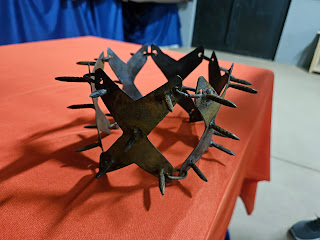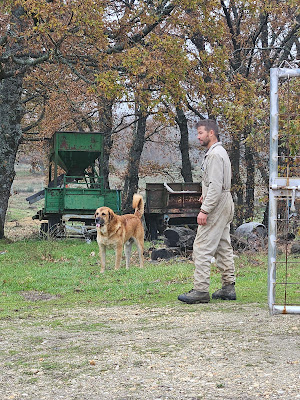Good homes
©Louise Liebenberg (2023)
Written for The Shepherds Magazine.
When I read through many of the social media livestock
guardian dog (LGD) pages, I am absolutely shocked at the number of dogs looking
for a new, good home. It is not just the odd one here and there but instead a
continuous stream of failed LGD looking for a great non-working home, someone
looking for a placement of their dog on a bigger ranch, or with a more
experienced trainer. Friends of mine who work with rescues are overwhelmed with
the shear number of LGD and mixes of LGD entering the shelter/ foster system,
and within that system, there simply are not enough good homes for all these
unwanted LGD. In many cases, it is not
even just LGD mutts that end up in rescues, a lot of purebred dogs can be found
there too. The number of “rehomes” is excessive, however the number of litters
from LGD breeds being advertised is staggering, many of which, are not even from
working dogs. In all honesty, there is little to no market for most of these
pups. Recently, a breeder has struggled to give away, for free, a litter of a
rare breed LGD pups. Ultimately, these pups are 4 or 5 months old, become a
handful to handle and are expensive to feed, these pups ended up in a variety
of homes, whether suitable or not, simply to “get rid of them”, the leftovers
ended up in a shelter. Many of the people who drop off these pups in a shelter hope
they will find that illusive “good home”. For many of these pups, the good home
ends up being euthanasia.
The myth of the good home needs to be addressed. Those folks looking for a new placement for
their roaming, sheep worrying or chicken killing dogs have this idea that these
dogs would be better suited to a bigger ranch. What many people forget is on
larger, commercial operations, the sheep or cattle are the main source of
income and the people who live this lifestyle, are often very busy. It takes
time to graze animals, check fences, doctor sick animals, haymaking. Few shepherds
are willing to take on an uncontrolled, problematic dog, often with
questionable genetics and poor raising. These dogs can be a threat to their own
livestock (and livelihood) and few have the time to invest in someone else’s
failed dog. It is not simple to rehabilitate a failed LGD. The person wanting to find the “good home” does
not understand the risk, stress, time and cost it would take to make this type
of dog into a functional dog. I know, I would not risk my own sheep’s lives or
risk the chance of my own dogs getting injured in such a situation.
If the “good home” is not a large sheep operation, perhaps
it is with small acreages or homesteads? Sadly, these places are often not suitable
for failed LGD either. Most homesteads or micro farms have neighbours who may
not appreciate a LGD barking all night. Most smaller homesteads do not have the
work for the dog or the ability to fence to contain a roaming LGD. Few people
are willing to risk having a large breed dog, who has perhaps shown some
killing behaviour around livestock, be in contact with their own and neighbors’
children. Added to this, there is not
only the threat of a bite incident with an unknown adult LGD, but the liability
of a dog roaming and potentially causing a vehicle accident is just too
overwhelming for most people to contemplate. Few homesteaders have the
experience to work with a problematic dog.
Finally, the in-town, pet home is an even less likely option. Their natural
guarding behaviour, their canine aggressiveness, their stranger wariness, the strength,
and size simply do not lend themselves to town or pet living situations. There
simply is no demand or not enough good homes for unwanted LGD.
The “good home” for the failed LGD rarely exists. People who
start with LGD need to be aware of this. Few people are wanting a wool pulling,
lamb eating, chicken killing, calf chasing large breed dog. The moment you take
that cute pup or multiple pups’ home, your options for an alternative home “if
they don’t work out” is almost non-existent. The responsibility of breeding and
placement is with the breeder. However, it is the first owner’s responsibility
to give this pup the best chance of success and to commit to owning this dog
for its life span. It is very important that new owners are supported in making
the best decisions they can to ensure the pup has a lifelong home.
Sometimes the best decision is for the person enquiring
about LGD, is to choose to not get an LGD. As hard as it maybe to hear, not every
situation warrants an LGD. Many of the rehomes are coming from smaller
homesteads who only have a few poultry or maybe a handful of other livestock.
Many people are unprepared for the work it takes to get a dog to be reliable
with poultry and other small stock. Few are prepared for the sheer determination
a LGD can have to escape from its pen, or the aggression it can display towards
strangers or animals unfamiliar to it. The time, cost and work it takes to get
a poultry safe dog is vastly underestimated.
It is time for the LGD community to say no to selling pups into situations
where the chance of failure is high. We need to be vocal about how most LGD
were never bred to be guardians of poultry or rabbits, and that most immature
LGD will harm them, given the opportunity. They were bred to cover large
distances moving with the shepherds and their flocks and are mostly not suited
to small acreages. They are strong and independent thinkers which makes them
hard to train, obedience is not a top priority for these breeds. They are
physically strong dogs who do best in serious working situations. We need to
talk about how not all LGD work out, many do harm stock while growing up, it is
a challenge to keep them fenced in on smaller places, they bark a lot, they are
not always the friendliest dogs, they might even kill the beloved cat. Many
people need a large dose of realism and people new to LGD need to hear this.
Part of the problem also lies in the volume of LGD and LGD
crosses being bred. It is hard to manage intact animals. Perhaps, the continual
pushing of later spay and neutering is contributing to the excessive number of
pups being born. Of course, in a perfect world, it is better to hold off on
spaying and neutering until the dog is over two years of age, but the reality
is heat-cycles in females are easily missed and before you know it, the LGD is
bred by the collie. Few people are even capable of recognizing when their
female is in heat, and many do not have a place to lock her up in for a three-week
stint. There is a risk in everything, our dogs live a risky lifestyle. Early
spaying and neutering might have some health risks, but so does pregnancy and
unwanted litters. Spaying and neutering
makes for more manageable working dogs, and I am a firm believer that owners
should make the decision when to spay and neuter based on what works best for
their operation.
Finally, we need to call out bad management and raising
practices that contribute to failure in LGD. Quite frankly, we need to keep the
“pet dog” mentality out of the working dog world. Many LGD fail due to
misconceptions that pups can only bond to their owners and families while
living in a house. Or, the notion that
the pup must bond first to its human family before it gets placed with the
livestock. The sad thing is, this LGD
shelter and unwanted pups’ problem reflects on our industry. The ranchers and
shepherds who need working LGD are viewed as the cause of the problem. We need
to be cognizant of this. As a livestock
and LGD owning community, we need to do our best to help curb the enormous
influx of these breeds into shelters and the number of LGD being bred. We can
do our part by educating and mentoring suitable owners and dissuading the
acquisition of a LGD into situations with a high chance of failure. We need to talk about the realities of owning
these dogs, and taking responsibility for the dogs we bring onto operations.
The mythical good home does not exist and often the outcome for the failed LGD
is death.















